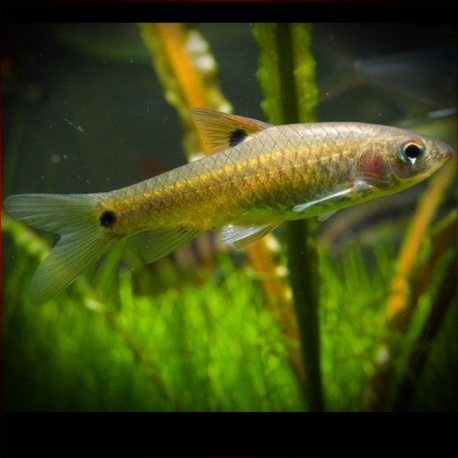More info
Datasheet
| Minimum Tank Size | 60 litres / 15.85 US gallons |
| Maximum Size | 5.0cm / 1.97inches |
| Temperature | 18°C / 64.40°F - 24°C / 75.20°F |
| Hardness | 2.02dgH / 36ppm - 15.02dgH / 268ppm |
| pH | 6.0-7.5 |
General Description
The Two-Spotted Barb, scientifically known as Puntius Bimaculatus, is a species of fish in the Cyprinidae family. This small-sized fish has an average maximum size of 5.0cm and is sometimes referred to as the "redside barb." It is typically found in densely-planted freshwater habitats in Southern India and Sri Lanka, displaying a distinctive color pattern with two dark spots at the base of its dorsal and caudal fins.
Aquarium Setup
The Two-Spotted Barb thrives in a densely-planted tank, making it an excellent choice for carefully-aquascaped setups. Floating plants and driftwood can be added to provide shade and a natural environment. While water movement should not be overly strong, the species prefers slightly acidic to neutral water with temperatures between 18-24°C and hardness ranging from 36-268ppm (see table).
Behaviour
Known for its peaceful nature, the Two-Spotted Barb is an ideal resident in community aquariums. This schooling species thrives when kept in groups of at least 6-10 individuals, leading to reduced skittishness and enhanced color development in males due to conspecific competition.
Feeding and Diet
In the wild, the Two-Spotted Barb feeds on diatoms, algae, small insects, worms, and zooplankton. In aquariums, they readily accept small live and frozen foods like bloodworms, Daphnia, and Artemia, alongside quality dried flakes and granules with plant or algal content.
Reproduction & Dimorphism
During reproduction, Two-Spotted Barbs are egg-scattering free spawners with no parental care. For optimal breeding conditions, a controlled setup with dim lighting, mesh or matting for egg collection, and slightly acidic water is recommended. Adult females appear larger and bulkier than males, with males exhibiting brighter coloration.
Habitat and Distribution
These fish inhabit various freshwater habitats ranging from flowing hill streams to river middle reaches, predominantly in Southern India and Sri Lanka. In Sri Lanka, they are found in mountain streams above 1500m elevation, while detailed distribution includes river basins in multiple Indian states.
No conclusion should be drawn from this information as it is presented as facts based on the provided details.

